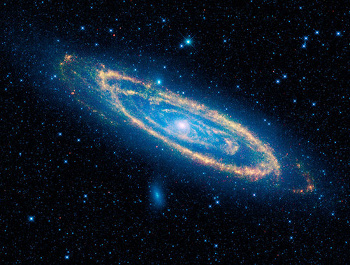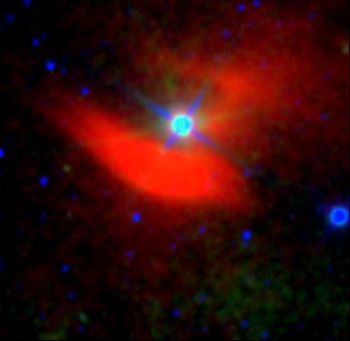Dearth of Dyson Spheres
May 21, 2015
In a
recent article (Gamma Ray Bursts and the Fermi Paradox, March 19, 2015), I discussed the
Fermi paradox, named after the prominent
physicist and recipient of the 1938
Nobel Prize in Physics,
Enrico Fermi. In 1950, Fermi made a
first principles estimate of the supposed number of
extraterrestrial civilizations. This estimate, combined with an estimate of how quickly such civilizations would spread throughout the
galaxy, leads to the idea that we
Earthlings should have seen some sign of them by now.

Monument marking the War of the Worlds landing site at Grover's Mill, New Jersey.
The monument is located in Van Nest Park in West Windsor Township, New Jersey.
(Via Wikimedia Commons.)
While some would claim that
Earth is often visited by
space aliens, the absence of convincing
evidence for this in an age in which everyone carries a
cellphone camera is a good argument that this isn't happening. So, why are space aliens missing? Among possible reasons is the
rare Earth hypothesis that the
abiogenesis of life is harder than we suppose. There's also the grim possibility that
intelligent life always finds a way to destroy itself.
A
technological singularity, in which a
species cedes control of its
destiny to an
artificial intelligence, might happen eventually, and this intelligence isn't interested in
exploration. Extraterrestrials might be so advanced that Earth is not interesting enough for a visit; or, they
keep us isolated. However, there's the distinct possibility that life is frequently
destroyed by natural events, such as
extinction-level meteor impacts, and it never has a chance to achieve
galactic colonization.
We're now
technologically advanced enough to prevent our demise by meteor impact, given enough warning. However, a nearby
gamma ray burst is not preventable, and this could extinguish all life on Earth. About one gamma ray burst is detected daily by satellites, all of these bursts occurring in other
galaxies. These distant bursts are so
energetic that they still have an affect on the Earth.
Earth was assaulted by an intense gamma ray burst, designated
GRB 130427A, on April 27, 2013. This burst had a peak energy of 95 billion electron volts. The energy of GRB 130427A was safely absorbed by Earth's atmosphere, since the burst happened at a distance of about 3.8 billion
light years.[1] Fortunately, the
probability of such an intense burst happening in our
our own galaxy is less than 1 in 10 million,[2] but a smaller gamma ray burst close to the Earth would destroy the ozone layer. This would allow the
Sun's ultraviolet radiation to reach the
Earth's surface,
sterilizing most of the
planet.
A recent study examining the role of gamma ray bursts in the extinction of life in our galaxy, and other galaxies, has shown that gamma ray bursts are the likely reason why life in the
universe is so rare.[4-5] There's a 95% probability of lethal bursts within four
kiloparsecs (kpc) of our
galactic center, and this probability drops to 50% only at the periphery of the
Milky Way.[4] Since gamma ray bursts are more frequent in high
mass galaxies containing a high concentration of heavy
elements, life can exist in just 10% of galaxies.[4]
Theory is one thing, but it's more satisfying to actually do a search. The
SETI program of listening for intelligent signals from
stars in our own galaxy has been underway for
decades, with no positive result. Is there a way that we can look for a sign of an advanced civilization in other galaxies?
A sure sign of our own civilization is our energy signature. We've been
harvesting and using huge quantities of energy from our
environment, in the form of
coal and
oil, for more than a
century; and, as a consequence, we've been generating a lot of
heat. About fifty years ago, physicist
Freeman Dyson had the idea that advanced extraterrestrial civilizations could be detected by their own heat signature through enhanced
mid-infrared emission.
In order to harvest as much energy as possible from host stars, such civilizations would trap nearly all the star's energy by constructing a huge
sphere around the star. Such
Dyson spheres would radiate in the infrared. Today, with various
infrared space-based telescopes, such as
NASA's Wide-field Infrared Survey Explorer (WISE), it's now possible to detect such an infrared signature from other galaxies.

In this WISE, false-color, mid-infrared image of the Andromeda galaxy, orange represents the heat emission from star formation.
(NASA/JPL-Caltech/WISE image.)
Why do we think such a signal could be detected? In 1964,
Russian astronomer Nikolai Kardashev calculated the
scale of possible energy capture for various civilizations from our own (Type I) to a galactic civilization (Type III). We can potentially use all the
insolation of the Earth, about 10
16-10
17 watts, but a galactic civilization has access to a staggering 10
37-10
38 watts. If a large fraction of this energy converts to a mid-infrared excess, it could be detected.
In a recent study, the WISE
G-HAT (Ĝ) team searched for excess mid-infrared radiation for 100,000 nearby galaxies.[6-7] This survey looked at a thousand times as many galaxies as a previous survey, which looked at just a hundred.[6] The simple conclusion, as found in the paper
abstract, is that "No galaxies in our sample host an alien civilization reprocessing more than 85% of its starlight into the MIR..."[6]
As
Jason T. Wright, an
assistant professor at
Pennsylvania State University, who
proposed this study, explains,[7]
"Whether an advanced space-faring civilization uses the large amounts of energy from its galaxy's stars to power computers, space flight, communication, or something we can't yet imagine, fundamental thermodynamics tells us that this energy must be radiated away as heat in the mid-infrared wavelengths... This same basic physics causes your computer to radiate heat while it is turned on... The idea behind our research is that, if an entire galaxy had been colonized by an advanced spacefaring civilization, the energy produced by that civilization's technologies would be detectable in mid-infrared wavelengths -- exactly the radiation that the WISE satellite was designed to detect for other astronomical purposes."
The research team first examined nearly every object in the WISE catalog, about 100 million entries, for the subset of about 100,000 exhibiting excess mid-infrared radiation. Further examination gave about 50 galaxies with unusually high levels of mid-infrared radiation worth examining in more detail, but none of these were indicative of an advanced civilization utilizing most of the starlight in its galaxy. These galaxies are
billions of years old, which is plenty of time for their nearly complete colonization.[7]
Although no alien civilizations have been detected, WISE has detected some interesting natural objects. One of these is a bright
nebula around the nearby star
48 Librae (see figure). This nebula appears to be a huge cloud of dust around the star.[7]

WISE image of the 48 Librae mid-infrared nebula, which is not seen in visible light.
(Image: Roger Griffth (Penn State) / IPAC (NASA/JPL-Caltech), released under a Creative Commons-Attribution-NonCommercial-NoDerivatives, 2.0 Generic, license.)
Wright is not deterred by this negative result. Says Wright,
"We should be able to push our sensitivity to alien technology down to much lower levels, and to better distinguish heat resulting from natural astronomical sources from heat produced by advanced technologies. This pilot study is just the beginning."[7]
The G-HAT survey was funded by the
John Templeton Foundation.[7]
References:
- M. Ackermann and 181 Other Authors, "Fermi-LAT Observations of the Gamma-Ray Burst GRB 130427A," Science, vol. 343 no. 6166 (January 3, 2014), pp. 42-47, DOI: 10.1126/science.1242353.
- David Hopkins, "'Monster' cosmic explosion recorded," Telegraph (UK), November 22, 2013.
- Rebecca Morelle, "Gamma-ray burst brightest ever seen, BBC World Service, November 21, 2013.
- Tsvi Piran and Raul Jimenez, "Possible Role of Gamma Ray Bursts on Life Extinction in the Universe," Phys. Rev. Lett., vol. 113, Document No. 231102 (December 5, 2014), DOI: http://dx.doi.org/10.1103/PhysRevLett.113.231102. An arXiv preprint is available here.
- Michael Schirber, "Focus: Gamma-Ray Bursts Determine Potential Locations for Life," Physics, vol. 7, no. 124 (December 8, 2014), DOI: 10.1103/Physics.7.124.
- Roger L. Griffith, Jason T. Wright, Jessica Maldonado, Matthew S. Povich, Steinn Sigurdsson, and Brendan Mullan, "The Ĝ Infrared Search for Extraterrestrial Civilizations with Large Energy Supplies. III. The Reddest Extended Sources in WISE," The Astrophysical Journal Supplement Series, vol. 217, no. 2 (April 15, 2015), pp. 25ff., doi:10.1088/0067-0049/217/2/25.
- Barbara K Kennedy, "Search for advanced civilizations beyond Earth finds nothing obvious," Pennsylvania State University Press Release, April 15, 2015.
Permanent Link to this article
Linked Keywords: Fermi paradox; physicist; Nobel Prize in Physics; Enrico Fermi; Fermi problem; first principles estimate; extraterrestrial life; extraterrestrial civilization; Milky Way; galaxy; Earthlings; monument; War of the Worlds; Grover's Mill, New Jersey; West Windsor Township, New Jersey; Wikimedia Commons; Earth; extraterrestrial life; space aliens; evidence; camera phone; cellphone camera; rare Earth hypothesis; abiogenesis of life; intelligent life; technological singularity; species; destiny; artificial intelligence; exploration; zoo hypothesis; global catastrophic risk; extinction-level meteor impact; space colonization; galactic colonization; technology; technological; gamma ray burst; satellite; energy; energetic; GRB 130427A; electron volts; Earth's atmosphere; light year; probability; ozone layer; Sun; ultraviolet radiation; lithosphere; Earth's surface; sterilization; sterilize; planet; universe; kiloparsec; galactic center; mass; chemical element; theory; Search for extraterrestrial intelligence; SETI; star; decade; energy harvesting; environment; coal; petroleum; oil; century; heat; Freeman Dyson; mid-infrared emission; sphere; Dyson sphere; infrared; space observatory; space-based telescope; NASA; Wide-field Infrared Survey Explorer; WISE; false-color; Andromeda galaxy; star formation; JPL-Caltech; Russian; astronomer; Nikolai Kardashev; Kardashev scale; insolation; watt; G-HAT (Ĝ); abstract; Jason T. Wright; assistant professor; Pennsylvania State University; research proposal; computer; space flight; communication; thermodynamics; physics; age of the universe; billions of years; nebula; 48 Librae; visible light; Roger Griffth (Penn State); IPAC; Creative Commons-Attribution-NonCommercial-NoDerivatives, 2.0 Generic, license; astronomy; astronomical; pilot experiment; pilot study; John Templeton Foundation.